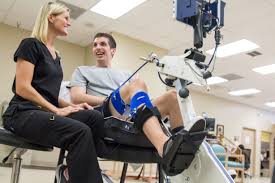Physical therapy role in an emergency department: Difference between revisions
Claire Knott (talk | contribs) No edit summary |
Claire Knott (talk | contribs) No edit summary |
||
| Line 3: | Line 3: | ||
== INTRODUCTION: == | == INTRODUCTION: == | ||
[[File:Images (4).jpg|thumb]] | [[File:Images (4).jpg|thumb]] | ||
Physical therapy in the hospital emergency department is a growing area of practice. Physical therapists in the emergency room can help patients start on the road to recovery early in the injury process, facilitating the possibility to improve outcomes in certain injury types.<ref name=":0">Verywellhealth. available from: http://www.verywellhealth.com/emergency-room-physical-therapy-4135939 </ref>. Typically, once the treating physician has evaluated the patient, physical therapists are consulted by the treating Emergency department physician to assist in the evaluation and treatment of a number of movement and functional disorders, such as low back pain, peripheral vertigo, and various gait disturbances. Patients receiving | Physical therapy in the hospital emergency department is a growing area of practice. Physical therapists in the emergency room can help patients start on the road to recovery early in the injury process, facilitating the possibility to improve outcomes in certain injury types.<ref name=":0">Verywellhealth. available from: http://www.verywellhealth.com/emergency-room-physical-therapy-4135939 </ref>. Typically, once the treating physician has evaluated the patient, physical therapists are consulted by the treating Emergency department physician to assist in the evaluation and treatment of a number of movement and functional disorders, such as low back pain, peripheral vertigo, and various gait disturbances. Patients receiving emergency department physical therapy (ED PT) benefit from the physical therapist’s expertise in musculoskeletal and vestibular conditions and from the individualised attention provided in a typical bedside evaluation and treatment session. This includes education on expected symptom trajectory, recommendations for activity modulation and facilitated outpatient follow-up<ref>Kim HS, Strickland KJ, Mullen KA, Lebec MT. Physical therapy in the emergency department: A new opportunity for collaborative care. The American journal of emergency medicine. 2018 May 24</ref>. As part the emergency department team, physical therapists have the opportunity to collaborate in the care of patients with a wide range of acute and chronic problems coming from the neuromusculoskeletal, cardiovascular, pulmonary and integumentary systems. | ||
== Function of emergency physiotherapist<ref name=":0" /> == | |||
1. Patient education about their injury or illness and how that affects their mobility | 1. Patient education about their injury or illness and how that affects their mobility | ||
2. Instruction in bed mobility, transfers | 2. Instruction in bed mobility, transfers and walking | ||
3. Instruction in using assistive device like a cane or a walker | 3. Instruction in using assistive device like a cane, crutches or a walker | ||
4. Prescribe exercises to help treat conditions | 4. Prescribe exercises to help treat conditions | ||
| Line 16: | Line 16: | ||
5. Provide pain relief like ice or heat for injury | 5. Provide pain relief like ice or heat for injury | ||
6. Provide suitable immobilisation for fractures and ligamentous injury such as backslabs, moon boots and Richard splints for example. | |||
References | References | ||
<references /> | <references /> | ||
Revision as of 02:27, 2 June 2019
INTRODUCTION:[edit | edit source]
Physical therapy in the hospital emergency department is a growing area of practice. Physical therapists in the emergency room can help patients start on the road to recovery early in the injury process, facilitating the possibility to improve outcomes in certain injury types.[1]. Typically, once the treating physician has evaluated the patient, physical therapists are consulted by the treating Emergency department physician to assist in the evaluation and treatment of a number of movement and functional disorders, such as low back pain, peripheral vertigo, and various gait disturbances. Patients receiving emergency department physical therapy (ED PT) benefit from the physical therapist’s expertise in musculoskeletal and vestibular conditions and from the individualised attention provided in a typical bedside evaluation and treatment session. This includes education on expected symptom trajectory, recommendations for activity modulation and facilitated outpatient follow-up[2]. As part the emergency department team, physical therapists have the opportunity to collaborate in the care of patients with a wide range of acute and chronic problems coming from the neuromusculoskeletal, cardiovascular, pulmonary and integumentary systems.
Function of emergency physiotherapist[1][edit | edit source]
1. Patient education about their injury or illness and how that affects their mobility
2. Instruction in bed mobility, transfers and walking
3. Instruction in using assistive device like a cane, crutches or a walker
4. Prescribe exercises to help treat conditions
5. Provide pain relief like ice or heat for injury
6. Provide suitable immobilisation for fractures and ligamentous injury such as backslabs, moon boots and Richard splints for example.
References
- ↑ 1.0 1.1 Verywellhealth. available from: http://www.verywellhealth.com/emergency-room-physical-therapy-4135939
- ↑ Kim HS, Strickland KJ, Mullen KA, Lebec MT. Physical therapy in the emergency department: A new opportunity for collaborative care. The American journal of emergency medicine. 2018 May 24







